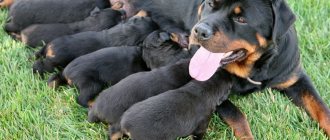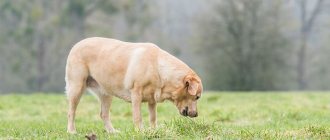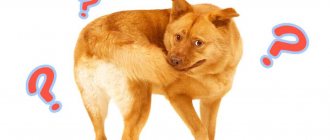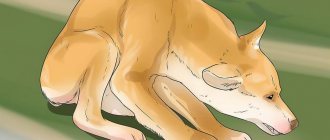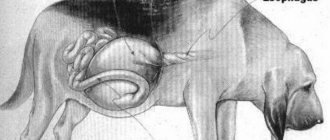Physiology of swallowing
Due to physiology, foreign bodies rarely enter the lungs. The larynx does not have its own protection; when swallowing, food particles or objects can get stuck in it. The act of swallowing in dogs is divided into three stages:
- Chewing food in the mouth. The process is controlled by consciousness; food (object) enters the oral cavity, where it is crushed into small pieces. It takes from a few seconds to minutes depending on the condition of the teeth.
- Direct swallowing. Controlled by a reflex arc. Triggered by irritation of the root of the tongue. The soft palate rises, blocking the communication between the pharynx and nasal cavity. This is why food cannot enter the respiratory system.
- Movement of the food ball. An involuntary reaction that occurs when the walls of the esophagus are irritated. As a result, food enters the stomach, where it is digested.
During any stage, the dog may choke and begin to cough up. Objects rarely get stuck in the esophagus or trachea - the pharynx has a limited size, which means that large, hard particles cannot travel further.
Possible causes of difficulty breathing
Coughing in dogs looks like signs of suffocation. It is a common symptom of many diseases, so it is important to distinguish between when a dog is coughing and when it is choking. Diseases accompanied by cough:
- Colds, rhinitis. With her, the dog makes sounds as if he was choking. It responds well to treatment, the acute form lasts up to several days.
- Kennel cough. The second name is adenoviral infection. It is characterized by a lingering dry cough caused by irritation of the upper respiratory tract. The temperature often rises.
- Allergy. Occurs upon contact with an irritant or food. She typically experiences difficulty breathing, which leads to collapse of the trachea. Accompanied by lacrimation, uncontrollable itching and redness of the skin.
- Heart failure. The animal periodically coughs during oxygen starvation - the enlarged heart puts pressure on the airways. The disease is more common in older dogs who are overweight.
Signs resembling suffocation can also occur with gastritis. When the disease worsens, vomiting occurs and the dog chokes on something.
Breeds with a short muzzle (brachycephalic) and small dogs can often choke. They may have a pathological structure of the palatal septum, which leads to blockage of the airways during eating. The problem is solved by surgical methods. Recovery must be careful; the dog can easily choke on the medicine.
Signs that a dog is choking
The symptoms of suffocation are quite characteristic, and it is difficult to confuse them with other manifestations. The following will indicate that the dog is in need of urgent help:
- coughing fits and hoarse, uneven breathing;
- head and neck, lowered and extended forward;
- ineffectual vomiting;
- profuse salivation, with inability to swallow saliva;
- rubbing with paws on the face and neck, in attempts to free oneself from an interfering object.
Almost always these manifestations are accompanied by panic and anxiety. The animal does not find a place for itself, rushes from corner to corner, squeals, whines, etc. Eating food and water is either difficult or completely impossible. Severe blockage of the airways can lead to clouding of consciousness, even fainting.
If a foreign object passes through the esophagus and enters the stomach, intestinal spasms, gurgling and other manifestations of intestinal obstruction may occur. Your pet may be in severe pain, and you won’t be able to help him on your own. In this case, you need to urgently contact a veterinarian.
Causes of suffocation
More often than not, dogs begin to choke after eating quickly. It is not uncommon for a dog to eat grass and choke. A large piece of food, large dry food or a fish bone can cause choking. Common reasons why a foreign body gets stuck in the throat:
- Rush. Eating food quickly. This feature occurs in large and medium-sized breeds, with irregular and large meals, and the owner’s haste.
- Greed. The dog snorts and swallows the food without chewing it first. As a rule, this is observed in animals after prolonged hunger, in the presence of competition - when several pets eat from the same bowl.
- Ingestion of a foreign body. A similar feature is characteristic of representatives of large breeds. Due to the large size of their mouth, they can swallow socks, a ball or a large bone.
- Gluing dry food. If you are in a hurry or if there is excessive salivation, the pieces may stick together into a lump, and your pet may choke on them.
Dogs should absolutely not be fed tubular (bird) bones or fish without preliminary cutting. Sharp pieces of bone can get stuck in the gums, throat, or puncture the stomach. Against this background, an infection develops, which can be fatal. There is a risk of internal bleeding and painful death of the pet.
What should the owner do if there is a symptom?
If the dog begins to choke, and this symptom was preceded by fights (biting) with other animals, especially wild ones, then there is a possibility that this is a sign of rabies. The pet is urgently taken to the veterinary center, examined and a dangerous disease is confirmed/ruled out.
When a dog choke when the leash is pulled too hard, the owner should stop pulling or loosen the collar.
Complex of symptoms: cough + attempt to regurgitate and when the dog chokes, speaks of a foreign object in the throat. A suffocating cough indicates the need for urgent help; a foreign object blocks the trachea and the animal dies from suffocation.
With an allergic reaction, anaphylactic shock, severe swelling occurs in the pharynx and trachea. The dog begins to choke, cough, and choke. It is better to provide assistance at the RosVet EC; in a critical situation, dexamethasone (1-2 ml) is administered intramuscularly at home and the pet is delivered to the clinic as quickly as possible.
When the upper respiratory tract is affected (laryngitis, tonsillitis, tracheitis), the dog often regurgitates and gags. First of all, the underlying disease is eliminated; the symptom goes away after successful treatment.
Excessive salivation is one of the reasons why a dog chokes and does it regularly. There are many reasons for increased salivation, from viral infections, poisoning, tumors to inflammation of the mucous membrane and dysfunction of the salivary glands. The true cause is determined during examination, and treatment for the identified disease is prescribed.
Main signs of suffocation
When keeping a dog, you need to be able to distinguish a cough from a choking attack. Difficulty breathing can be identified by the following symptoms:
- the dog actively coughs and chokes;
- breathing becomes hoarse, the animal coughs;
- frequent vomiting occurs, which does not end with the release of masses. She barks like she's choking;
- the animal cannot swallow food, water or its own saliva (spits it);
- the head and neck are in a lowered position, the pet groans and does not respond to sounds;
- the dog cannot stand on its feet, falls and does not get up on its own, constantly coughs and loses consciousness;
- blue mucous membrane;
- anxiety and panic attacks, the animal tries to expel the foreign body and strongly rubs its neck with its paws.
External manifestations depend on the size of the dog and the characteristics of the stuck object. The most dangerous is the ingestion of sharp elements - they lead to damage to internal tissues, and there are patches of scarlet blood in the saliva. When large round objects enter the body, pain occurs on palpation of the esophagus and persistent changes in breathing.
Signs of choking in dogs
If you have not encountered choking in a four-legged friend before, you may not immediately understand that your help is needed. Symptoms of lack of air:
- Breathing is heavy, uneven, wheezing or “gurgling” can be heard.
- A sharp, severe cough appeared.
- There is vomiting (unlike coughing, it involves the abdominal muscles, not the chest).
- The dog chokes on saliva and cannot swallow it.
- It’s also not possible to push an object through with water.
- The pet behaves restlessly, whines, and seeks help.
- The head hangs down.
- The inner surface of the mouth takes on a bluish tint.
Signs of respiratory spasm may vary.
Large objects provoke a gag reflex, the urge is aimed at pushing out. Small sharp things cause pain, the dog whines, “wipes” his face with his paw, and red spots appear in the saliva. Mostly unconditional mechanisms allow you to independently spit out a foreign body, but sometimes you cannot do without the help of the owner. Prolonged asphyxia will lead to loss of consciousness and death.
Dog first aid technique
If you notice that your pet is wheezing, behavior has changed and vomiting is observed, you should take action as soon as possible. First of all, examine the oral cavity for the presence of a stuck foreign body. Start actively stroking your throat with your palm to relieve an attack of nausea (often a foreign object comes out with vomiting). If the dog choked and lost consciousness, perform resuscitation yourself.
Action algorithm:
- Place the dog on its right side on a flat surface, the floor.
- Inspect the oral cavity for the presence of foreign objects, lay your tongue along the jaw.
- Place your hands on your sternum and press until you hear the sound of air escaping.
- Repeat the manipulation until the animal’s natural breathing returns to normal.
For small dogs up to 16 kg, mouth-to-nose artificial respiration can be performed. To do this, place the dog on the right side, extend the tongue to the incisors. Close your mouth and begin to slowly inhale air into your nose until your chest rises slightly. Release the animal and let the air come out on its own. Repeat the manipulation at intervals of 3-5 seconds. The jaw must be closed during the process.
Help with swallowing sharp objects
If the cause of choking is swallowing a sharp object, it is important to induce the swallowing reflex. To do this, you can give a small piece of meat or bread crumb, or perform a manual throat massage. Emergency measures if there is no result:
- Firmly fix the dog's body, grab it with your hands by the skin between the ears.
- Pull back your lower jaw to expose your teeth.
- Examine the oral cavity using a flashlight.
- Remove the foreign object with your fingers or tweezers.
You cannot push the bone into the esophagus - this leads to mechanical damage to the tissue and death.
Help with swallowing round objects
If a dog is choking on a small ball, it should be pushed out of the larynx. To do this, feel for the object, press on it from the bottom, trying to push it up. Large pets can be helped in the following ways:
- Stand behind the dog, clasp the body with your hands at the junction of the abdomen and sternum.
- Press your body forward and upward.
- Repeat until the ball or ball comes out.
Photo: www.forgottothink.com
Usually 3-5 repetitions are enough. Small breeds should be held on your lap with their back pressed against their belly. Place your hand on your sternum and hold your head. Press firmly on the area, trying to move the object towards the larynx area.
When a dog loses consciousness
Unfortunately, in many cases of severe choking, the dog loses consciousness very quickly. Then we should lay him on his right side and check that the heart beats regularly and quite quickly (from 70 beats at rest in large dogs to 120 in small and young dogs, although it speeds up in a stressful situation), and the dog is breathing (this should be 15-30 breaths per minute). Typically in this situation she should breathe through her nose. Position the dog's head so that the esophagus is in a straight position, open the mouth and extend the tongue outward until it stops. You can then check to see if whatever the dog choked on can be removed. If the dog is not breathing and the heart is not beating, resuscitation is necessary...
© shutterstock
Possible consequences of suffocation
If a foreign object becomes lodged in the larynx, there is a risk of swelling, which can be fatal. In addition, there is a possibility of intestinal obstruction, damage to internal organs and bleeding. Fish bones left in the mouth can cause gum disease and soft tissue infection. You should help your pet as soon as possible if he is choking on a bone.
If you can't help
If you cannot help at home, it is important to contact your veterinarian as soon as possible. Foreign objects are sometimes impossible to feel on your own; if they remain in the body for a long time, they cause serious problems. They can be detected by x-ray or ultrasound. In addition, only a veterinarian can prescribe medications to reduce inflammation, swelling and, if necessary, perform surgery. An emergency visit to the clinic can save your pet’s life, so you should not hesitate if he is choking on air, a bone or another object.
What can you do to prevent your dog from choking?
There are several methods of prevention. Useful tips:
- take short breaks between meals, make the daily norm for 3-4 servings;
- during feeding, provide the dog with silence and comfort;
- use special bowls with dividers for dogs that quickly swallow food and cough;
- do not give uncut fish or bird bones;
- choose toys depending on the size of the mouth and the dog itself;
- remove small objects from the animal’s access area;
- pay attention to an animal that is burping or grunting with its nose.
It is important to know the phone number of the nearest veterinary clinic in order to save time searching for contacts in an emergency.
The dog choked - how to prevent it?
We cannot prevent such situations from occurring, but there are still factors that can reduce the risk of its occurrence. Often a dog's choking is a consequence of greedy eating on a daily basis. If you feed your dog dry food, invest in food-slow bowls and hand feed. If it's wet food, you can give the food in a toy that the dog can lick. If you are starting a new diet and are concerned that your dog is eating meat and bones too greedily, try hand feeding him first to prevent him from swallowing large portions.
If your dog eats trash on walks, it needs to be done in a hurry - after all, he doesn't want to give it back, he wants to eat it. In such a situation, it is worth training the “Fu” team. We start this kind of work at home, even with a simple game: we scatter treats on the floor for the dog, put on a collar and leash, and put much tastier prizes in the dog’s pocket. When your dog approaches a food spill, say Fu without stopping your dog from picking it up, then reward him with a treat from your pocket. After a few repetitions, the dog should learn to listen to you.
Sometimes a dog may choke during walks and exercises. Don't reward your dog with hard snacks if he's running around and going crazy. When you are practicing commands and want to reward your dog, choose something soft, such as boiled poultry gizzards, cut into small pieces. A soft treat will go down your dog's throat easier. Avoid feeding your dog in a moving car.
Briefly about the main thing
- Coughing due to structural features of the larynx or diseases is similar to suffocation. It is important to be able to determine the causes of an animal’s breathing problems.
- Dogs often dander when eating quickly or swallowing various objects. Provoking factors are haste, greed and dry food sticking together.
- Symptoms of suffocation are blue mucous membranes, difficulty breathing, nausea without vomiting, loss of consciousness.
- If the dog is choking, you need to check for foreign objects in the oral cavity and massage the larynx. If necessary, perform artificial respiration.
Why does a dog choke: reasons
The list of factors that can cause an unpleasant symptom is extensive and is associated with the anatomical features of the structure of the pharynx, internal diseases or the action of external irritants. The veterinarian considers the following situations:
- brachiocephalic syndrome is observed in dogs with a specific structure of the muzzle, airways, pharynx and trachea. The pet is choking due to the special position of the soft palate, when trying to take a “quick”, deep breath, when running, overcoming obstacles or other physical activity;
- a tightly fastened collar, squeezing the throat when pulling on the leash. In this case, suffocation occurs and the dog chokes;
- release of helminth larvae into the tracheal lumen;
- feeding on tubular chicken bones and accumulation of their fragments in the esophagus;
- severe drooling. If a quick and deep breath is unsuccessful, the pet may choke.
The dog chokes and coughs if there are neoplasms of various origins in the larynx and oral cavity. Choking can occur due to a long break between feedings, when the pet greedily swallows food in large pieces.


